

Kids cooking. Kids recipes. Recipes for Kids. Kids Recipes. The Wartime Kitchen: Living of Rations with Ration Book Cooking - Day One. UKHOMEFRONTS VERY OWN WW2 RECIPES. We can say what we like of Lord Woolton.Or at least we can say what we dare.But England must sit up and listen.When Woolton is heard on the air.Our portions may be microscopic.But they grow every moment more dear.And Woolton dictates on a topic.That touches us near.
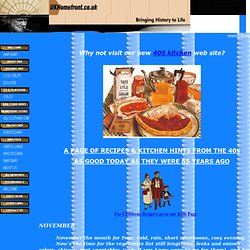
Some Ministers willing and blameless.And busy as beavers no doubtYet strike us as perfectly aimless.When they tell what the war is about.But Woolton looms ever beside us.Controlling each bite and each sup.And we count on his broadcasts to guide us.That something is up. Some Lords in the throes of digestion.Enlarge at regrettable length.On the rather incongruous question Of winning, through misery strength.But from Wooltons more fruitful endeavourOn the value of foods which however, we cannot obtain.
Rosehip Syrup recipe The directions given by the Ministry of Food during the war for 2 pounds (900gm) of hips. Method. Eating for Victory: original Second World War ration recipes. World War Two Recipes. During World War Two the government produced a raft of recipes that each family could use.
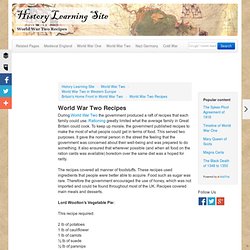
Rationing greatly limited what the average family in Great Britain could cook. To keep up morale, the government published recipes to make the most of what people could get in terms of food. This served two purposes. It gave the normal person in the street the feeling that the government was concerned about their well-being and was prepared to do something. It also ensured that wherever possible (and when all food on the ration cards was available) boredom over the same diet was a hoped for rarity. The recipes covered all manner of foodstuffs. Lord Woolton’s Vegetable Pie: This recipe required: 2 lb of potatoes 1 lb of cauliflower 1 lb of carrots ½ lb of suede ½ lb of parsnips 3 or 4 spring onions Water for cooking 1 teaspoon vegetable extract 1 tablespoon of oatmeal Chopped parsley.
WW2 People's War - Rationing and Wartime Recipes (P.M.) Recipes From World War 2 Home Front. How we survived in a time of rationing 1939 – 1953. Welcome to our new section devoted to Wartime Recipes.
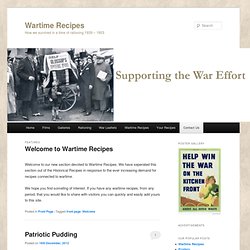
We have seperated this section out of the Historical Recipes in response to the ever increasing demand for recipes connected to wartime. We hope you find someting of interest. If you have any wartime recipes, from any period, that you would like to share with visitors you can quickly and easily add yours to this site. We have just published a new set of war-time recipes on our main site taken from the Good Fare Recipe Book first published in 1941. Here is a sample recipe. Patriotic PuddingIngredients 4 table-spoons Flour 4 table-spoons grated raw Potato or Fine Oatmeal 1 table-spoon Fat ½ table-spoon Jam, Treacle or Milk and Water to mix Syrup and 1 grated Carrot ½ tea-spoon Bicarbonate of Soda Pinch of Salt 2 tea-spoons grated Orange or Lemon Rind (if available) Milk and Water to mix Method: Rub the fat into the flour, add the rest of the dry ingredients and mix well. Potato Short Bread Parsley Honey Rhubarb Jam Without Sugar. The 1940's Experiment. Food Rationing during World War 2.
Before the Second World War started Britain imported about 55 million tons of food a year from other countries.
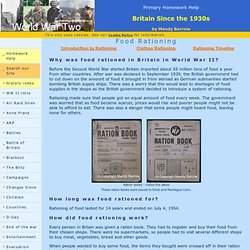
After war was declared in September 1939, the British government had to cut down on the amount of food it brought in from abroad as German submarines started bombing British supply ships. There was a worry that this would lead to shortages of food supplies in the shops so the British government decided to introduce a system of rationing. Rationing made sure that people got an equal amount of food every week. The government was worried that as food became scarcer, prices would rise and poorer people might not be able to afford to eat. There was also a danger that some people might hoard food, leaving none for others. Ration books - notice the dates These ration books were issued to Doris and Montague Corri.
Primary History - World War 2 - Food and shopping. Food Rationing during World War 2. Before the Second World War started Britain imported about 55 million tons of food a year from other countries.
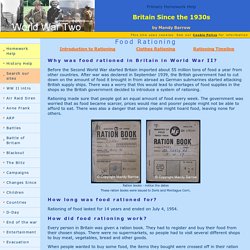
After war was declared in September 1939, the British government had to cut down on the amount of food it brought in from abroad as German submarines started attacking British supply ships. There was a worry that this would lead to shortages of food supplies in the shops so the British government decided to introduce a system of rationing. Rationing made sure that people got an equal amount of food every week.
The government was worried that as food became scarcer, prices would rise and poorer people might not be able to afford to eat. There was also a danger that some people might hoard food, leaving none for others. Ration books - notice the dates These ration books were issued to Doris and Montague Corri. Rationing of food lasted for 14 years and ended on July 4, 1954. Every person in Britain was given a ration book. Page inside a ration book.